2020-2021 Marker Duke PT 16
Test Location: Crested Butte, Colorado
Days Tested: 8
DIN Release Value Range: 6-16
Available Brake Widths: 100, 125 mm
Climbing Aids: “neutral,” 10°
BSL Adjustment: 60 mm
Stated Weight per Binding:
- Uphill Mode (alpine toe removed): 1050 grams
- Downhill Mode (alpine toe attached): 1350 grams
Blister’s Measured Weight per Binding:
- Tech Toes: 271 & 271 grams
- Alpine Toes: 309 & 310 grams
- Heel Pieces: 483 & 484 grams
- Heel Plates: 109 & 109 grams
- Brake Units (125 mm): 210 & 210 grams
- Uphill Mode (alpine toe removed): 1073 & 1074 grams
- Downhill Mode (alpine toe attached): 1382 & 1384 grams
Boot Compatibility: Alpine (ISO 5355), Alpine Touring (ISO 9523), & GripWalk
MSRP: $699
Boots Used: Atomic Hawx Prime XTD 130, Lange XT3 130 LV, Atomic Hawx Ultra XTD 130, & Tecnica Zero G Tour Pro
Ski Used: Volkl Blaze 106, 186 cm
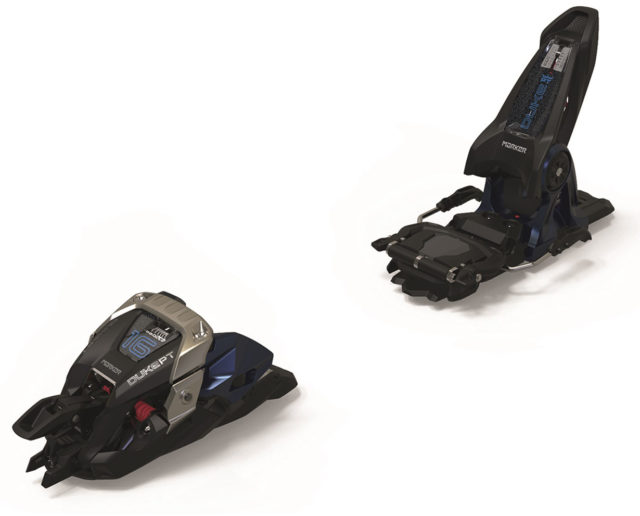
Intro
In November of 2019, Marker announced a brand-new touring binding, the Duke PT.
Many people out there know the regular Marker Duke as one of the very first “frame” AT bindings, but this new Duke PT is something completely different. Basically, the Duke PT lets you skin uphill in a pin / tech toe, but then ski down in what is essentially an alpine binding with similar elasticity and certified release characteristics of other alpine bindings.
That combination is something that only two other currently available touring binding systems on the market currently offer, and in theory, it’s basically the holy grail of freeride touring bindings: all the efficiency of a minimal tech binding, plus all the downhill performance of your trusty alpine bindings.
We got a pair of the Duke PT 16 this spring and were able to spend some time skinning and skiing in it around the backcountry of Crested Butte. So here we’ll go over its design, show you how it works in our video below, and then provide our initial impressions on how this binding performs and how it compares to the rest of the market.
Deep Dive Comparisons
Become a Blister Member or Deep Dive subscriber to check out our AT Binding Deep Dive where we directly compare the Duke PT 16, Salomon Shift MNC 13, CAST Freetour, Marker Kingpin 13, Fritschi Tecton 12, Fritschi Vipec Evo 12, Dynafit ST Rotation, & G3 ION 12, and discuss what you tend to gain and give up by going to much lighter AT bindings.
Weight & Comparisons
The Duke PT is not a particularly lightweight touring binding. In uphill mode, it’s much lighter than most frame-style bindings, but it’s still heavier on the uphill than all of the other binding systems that let you skin up with a tech toe piece.
That said, for those who are interested in a touring binding that lets them ski down in the equivalent of an alpine binding, the Duke PT 16 isn’t massively heavier than the other two options you currently have, the Salomon / Atomic Shift MNC 13 and the CAST Freetour system. (There’s also the B.A.M. Pindung, which should be available for the 20/21 season and has a stated weight of 1390 g.)
Compared to the Shift MNC 13 with 110 mm brakes, the Duke PT 16 with 125 mm brakes is about 188 grams heavier per binding in uphill mode (based on our measured weights). Compared to the CAST system with 110 mm brakes in uphill mode, the Duke PT 16 is about 77 grams heavier.
For the backcountry skiers out there who are willing to sacrifice some downhill performance for a lighter binding on the uphill, the Duke PT 16’s weight will likely be a dealbreaker. For those who want alpine-binding performance on the down, the Duke PT 16 is still heavier than the other options out there, but how much that matters to you will come down to your personal preferences.
It’s also worth noting that Marker claims that the Duke PT 12 weighs 850 grams in uphill mode, which would bring it much closer to the weight of the Shift MNC 13 and lighter than the CAST system.
For reference, here are some of our measured weights (average per binding) for a few notable bindings:
626 g Dynafit ST Rotation 10 (105 mm brakes)
638 g G3 ION 12 (105 mm brakes)
682 g Fritschi Tecton 12 (120 mm brakes)
775 g Marker Kingpin 13 (75-100 mm brakes)
850 g Marker Duke PT 12 (uphill mode; stated weight)
886 g Salomon S/Lab Shift MNC 13 (110 mm brakes)
997 g CAST Freetour (weight on ski while touring; 110 mm brakes)
1074 g Marker Duke PT 16 (uphill mode w/ alpine toe removed; 125 mm brakes)
1150 g Marker Duke PT 12 (downhill mode; stated weight)
1383 g Marker Duke PT 16 (downhill mode; 125 mm brakes)
1478 g Salomon Guardian MNC 13 (115 mm brakes)
1530 g CAST Freetour (all parts included; 110 mm brakes)
Design — Toe Piece
While the Duke PT’s toe piece looks a bit complicated, it’s an impressive piece of engineering.
There are two parts to the Duke PT’s toe piece: the “tech toe” that’s screwed into the ski (which you only use to skin uphill) and the “alpine toe” that attaches to the tech toe and that you use for skiing downhill.
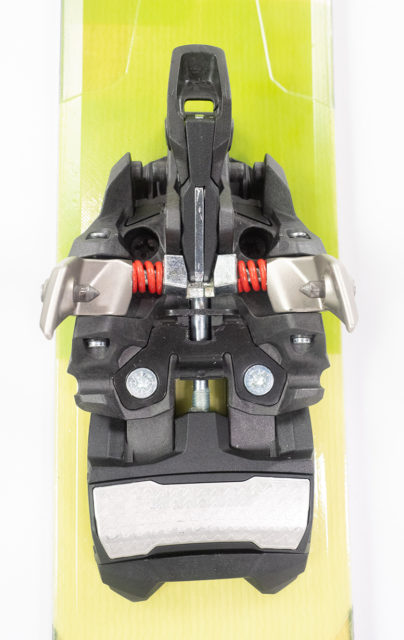
The alpine toe, which contains the spring that holds / releases your ski boot while skiing, can either be fully removed when skinning or left on the ski. As shown above in our video, you pop the alpine toe off the tech toe by pressing down the tech-toe lever just as you would on any other tech binding.
This releases three of the four connection points between the tech and alpine toe pieces. At this point, the alpine toe is pivoting off the remaining connection, which consists of two metal struts that attach to “nubs” (we’re getting really scientific here) on the tech toe. You can then fully flip the alpine toe piece forward so it’s flat onto the ski, where it’ll click into place and no longer move around. Or, you can pull up on the metal tabs on those struts and take the alpine toe fully off the ski and toss it in your pack, pocket, etc., thus reducing the weight you’re hauling on your skis.
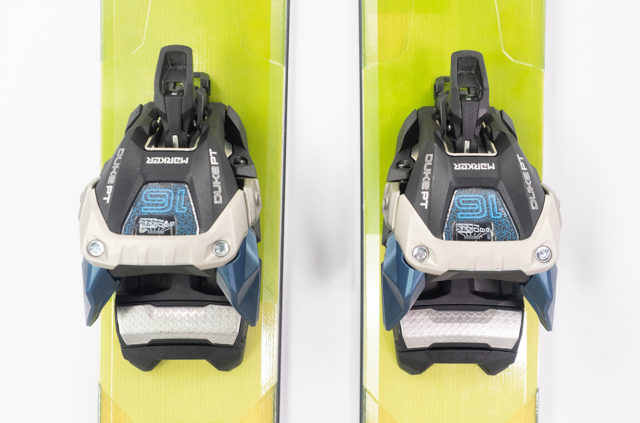
You repeat that process when it’s time to ski downhill, just in reverse. As I just mentioned, there are four connection points between the tech and alpine toe pieces on the Duke PT. Marker calls this system “Auto Quad Lock,” and the result is a very secure-feeling connection. The Duke PT’s tech-toe pins serve as two of the connection points, sliding into two corresponding holes in the alpine toe piece. The metal struts that you use to take off / put on the alpine toe piece serve as the next connection point. Finally, there’s a spring-loaded metal “hook” under the alpine toe (the little silver thing in the photo below) that slides forward and into a metal loop on the tech toe when it’s pushed forward while you step into the heel of the Duke PT. To get everything to connect, all you have to do is push down on the alpine toe piece and it responds with an audible and reassuring “click” when everything’s locked into place.
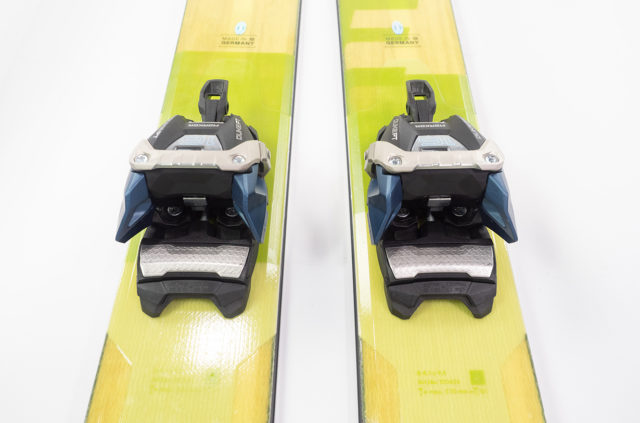
While this entire toe piece system is pretty complex, the actual tech toe you use for skinning is quite normal. It functions pretty much identically to the toe piece on the Marker Alpinist or current Marker Kingpin. Stepping into the Duke PT 16’s tech toe is just like stepping into the Alpinist and Kingpin — line up the pins with your boots’ inserts, push down with your boot, and the “wings” of the tech toes snap up and into the boot inserts. Then you can lock out the tech toe by pulling up on the toe lever, just as you would with other tech bindings.
Adjustable AFD & Boot Compatibility
The toe of the Duke PT features Marker’s “Sole I.D.” adjustable AFD (“anti-friction device) that makes it compatible with regular alpine, GripWalk, and ISO 9523 alpine touring soles. The AFD on the Duke PT can be raised or lowered to adjust to the varying soles on those three different sole types by turning a bolt via a Posi screwdriver at the front of the toe. This AFD system has so far proven totally reliable and hasn’t accidentally changed position, unlike the Shift is known to sometimes do when you adjust it to a new boot.
Like other “MNC” or “Multi-Norm Certified” bindings, the Duke PT will not work with touring boots that have soles that do not fit the ISO 9523 norm. Those boots have too short of toe and / or heel welts for MNC bindings. These non-certified boots usually come from the very lightweight touring category (e.g., Atomic Backland, Dynafit TLT series, Salomon X-Alp) and also include any boots with Dynafit’s “Speed Nose” design (e.g., Dynafit Hoji Pro Tour).
Design — Heel Piece, Brake, & Heel Riser
Compared to the toe piece, the Duke PT’s heel unit is pretty simple.
The Duke PT 16’s heel piece does not move along the ski like the Marker Kingpin since the pins on the Duke PT’s tech toe are forward enough on the ski that your boot heel won’t engage the Duke PT’s heel piece in tour mode. Functionally, the Duke PT 16’s heel piece is extremely similar to the heel piece on the Marker Jester. You step in and out of it just like a regular alpine binding, and same goes for adjusting the DIN settings.
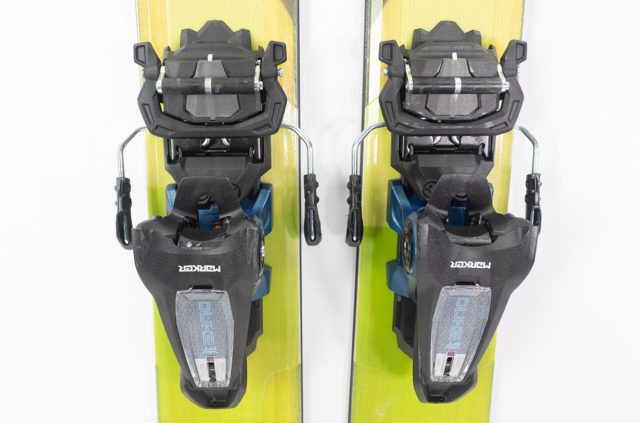
The brake on the Duke PT is unique, but again, pretty simple. There’s a small bar on the front of the brake pad that you flip up and back when transitioning to uphill mode. Once you do that and push down the brake pad, the brake arms will come up and stay locked up while skinning.
The Duke PT has a “neutral” climbing mode and then it has one heel riser that reportedly offers a 10° position. This riser is attached to the brake pad and sits flush with it in flat mode, and then you can flip it up and forward when your skin track gets steeper.
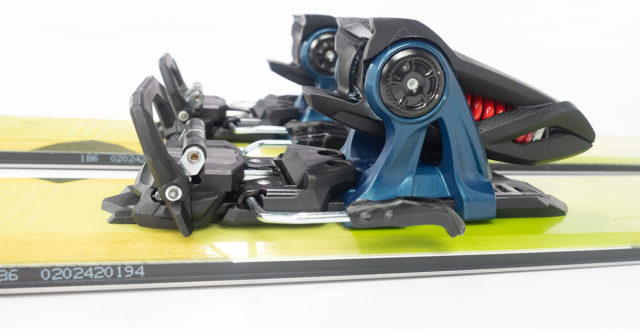
With its single heel riser, the Duke PT is similar to the Salomon / Atomic Shift, and those who tend to skin on a lot of very steep skin tracks may be left wishing they had a higher riser option (more on that below).
Transition Process
As we just showed in the video and spent many words describing, the Duke PT’s transition process is more complex than most touring bindings on the market, primarily due to its removable alpine toe piece. It’s also worth noting that, unlike many other, lighter touring bindings, you have to step out of the Duke PT to transition from uphill to downhill mode.
Despite this complexity, we haven’t had much trouble at all during transitions with the Duke PT. While I don’t ski with people who are extremely concerned with transitioning as fast as possible, I haven’t found myself holding up any of my touring partners when I’m using the Duke PT and they’re using other touring bindings.
That’s not to say that the Duke PT takes an equal amount of time to transition. It’s just that, if everything goes smoothly and I don’t have any trouble getting the alpine toe on / off, the tiny amount of extra time it takes to get the alpine toe on / off (~30 seconds) is usually negligible when you consider all the other things you need to do while transitioning (e.g., switch layers, buckle / unbuckle boots, rip / attach skins, etc.). So if you’re worried specifically about transition times, well, maybe that’s just an opportunity to get quicker at the other parts of a transition process. Or you’re just looking at the wrong binding.
You probably noticed the caveat I just mentioned, “if everything goes smoothly.” So far, everything has. Neither Jonathan nor I have yet had any issues getting the Duke PT’s alpine toe to attach or detach, and we’ve had no icing issues so far in conditions ranging from very deep, cold pow to slushy spring snow. But I mostly added that because that’s the area where we see the most potential for problems — in general, more complexity and more moving parts create more areas that can fail or create issues.
Again, we haven’t had any problematic icing or just generally any issues getting the Duke PT to transition as it’s supposed to, but this is something that we’re curious about going forward.
Uphill Performance
As I noted above, the Duke PT’s tech toe functions just like every other tech toe. So skinning with the Duke PT’s tech toe is great. There’s very little friction, I get just about 90° or range of motion (as much as I’d ever need), and overall, it’s just nice to walk uphill in this binding. In terms of ease of stepping into the tech toe, the Duke PT is identical to the Marker Alpinist — not the absolute easiest, but I also haven’t had much trouble.
The Duke PT’s “flat” mode looks a bit higher than truly flat, but I’ve never noticed this on flat skin tracks — it just feels flat.
Then there’s the heel riser. Many people will have zero issues with the fact that the Duke PT only offers one heel riser. If you are always setting your own, properly moderate-angle skin track or you just don’t find yourself needing super high risers very often, this won’t be a problem.
But you may have seen or heard my thoughts regarding the Salomon / Atomic Shift binding (which also only has one heel riser) and some other touring bindings with “high” risers that are relatively low (e.g., Marker Alpinist & Dynafit TLT Speed). I like high risers. Part of this is due to me being lazy and not wanting to set my own skin track when I encounter the very frequently steep skin tracks in Colorado. And part of this might also be due to my somewhat limited ankle dorsiflexion. Whatever it is, if I’m skinning on a steep skin track without a legit high riser, I usually end up with some pretty fatigued calves and some angry one-sided verbal exchanges with my bindings.
To be clear: my complaint isn’t limited to the Duke PT itself, it also applies to every other binding I’ve used that doesn’t have a very high riser option. With the current design of the Duke PT, I see why they didn’t add a higher riser — if they did, it would run into the heel piece of the binding when you flip it up. And fortunately, in the grand scheme of things, this is a pretty small complaint and I’ve just been forcing myself to set some more moderate-angle, arguably more “appropriate” skin tracks to compensate.
The other thing to note regarding uphill performance is the Duke PT’s heavier weight. When I’m switching between setups with much lighter tech bindings and go to the Duke PT, its extra weight is definitely noticeable. That said, it’s not really a huge deal in my mind. If you’re considering a very burly, downhill-focused binding like the Duke PT, I don’t think its weight is going to bother you a whole lot.
Downhill Performance
Finally, the fun part!
Ironically, this section will probably be the shortest, because during our testing so far … the Duke PT has skied exactly like an alpine binding.
By that, I mean that there is no discernable loss of power transfer nor any of the jarring vibration transmission typically felt when skiing in many full pin bindings (i.e., pins for both the heel & toe). For a binding that lets you skin up with pins, the Duke PT feels exceptionally solid on the descent.
I have had zero pre-releases in the Duke PT, despite skiing it quite hard in some brutally refrozen conditions. But it’s also released when I’ve tried and failed to practice my 3’s, which is something I rarely attempt on other touring bindings that aren’t certified to the same release characteristics as alpine bindings.
We’ll be able to directly A/B the Duke PT against some more bindings next season when the lifts are running, but we have not noticed anything different about the way the Duke PT skis vs. just about any alpine binding we’ve used, or the Shift binding, or the Pivot 18 (which is basically what the CAST system is in downhill mode).
And for those who haven’t spent time skiing in a regular alpine binding in a long time, it’s worth reiterating that the Duke PT feels so much better than any full-pin touring binding on the descent. There’s no “vague” feel in the heel, and it does a great job of absorbing the vibrations of rough snow rather than directly transmitting them to your feet and legs. If you frequently ski with tech bindings in the resort — especially if you ski hard in the resort — I’d encourage you to check out the many better-performing and safer bindings on the market right now (and the Duke PT is one of them).
Who’s It For?
So far, the Duke PT has proven to be a very solid option for a few different categories of skiers.
If you primarily ski in the resort but are thinking about touring in the future, the Duke PT makes a lot of sense. So far, it performs just like an alpine binding does on the descent, but goes uphill quite well when you need to earn your turns.
If you want a “50/50” binding to use pretty equally in the resort or in the backcountry, especially if more of your time is spent in the resort, the Duke PT also makes sense.
And then if you spend a lot of time in the backcountry with the primary goal of skiing very hard and / or throwing some tricks and / or dropping cliffs on the way down, the Duke PT is again a strong contender.
If you only ski in the backcountry and have been happy with lighter touring bindings, there’s not much reason to go to the heavier Duke PT. It’s certainly not going to be better on the uphill, and if you don’t have any major qualms about skiing in tech bindings, then you don’t need the Duke Pt. And if you know you’ll never skin uphill, just get a regular alpine binding.
But for those who want the downhill performance of an alpine binding but with the touring efficiency of a tech toe, the Duke PT is another appealing option in this still relatively new category.
Bottom Line
While the Marker Duke PT is a binding that looks pretty complex at first, it’s so far proven to be quite easy to use and provides exactly what Marker claims: the efficiency of a tech toe on the uphill and the general performance of a downhill binding on the descent.
We’re looking forward to skiing the Duke PT more next season to see how it performs after more time, so stay tuned for updates.
Deep Dive Comparisons
Become a Blister Member or Deep Dive subscriber to check out our AT Binding Deep Dive where we directly compare the Duke PT 16, Salomon Shift MNC 13, CAST Freetour, Marker Kingpin 13, Fritschi Tecton 12, Fritschi Vipec Evo 12, Dynafit ST Rotation, & G3 ION 12, and discuss what you tend to gain and give up by going to much lighter AT bindings.

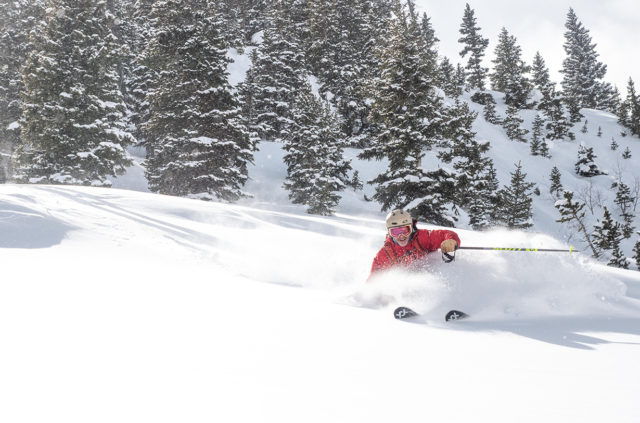
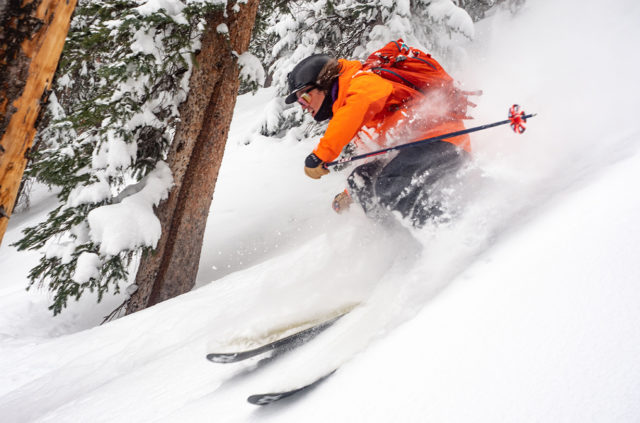
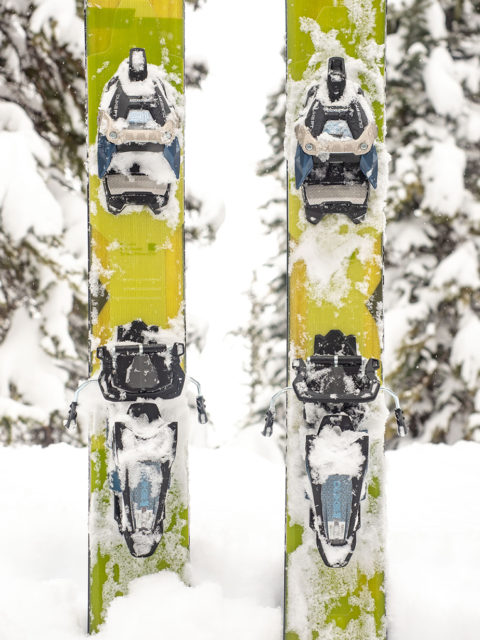
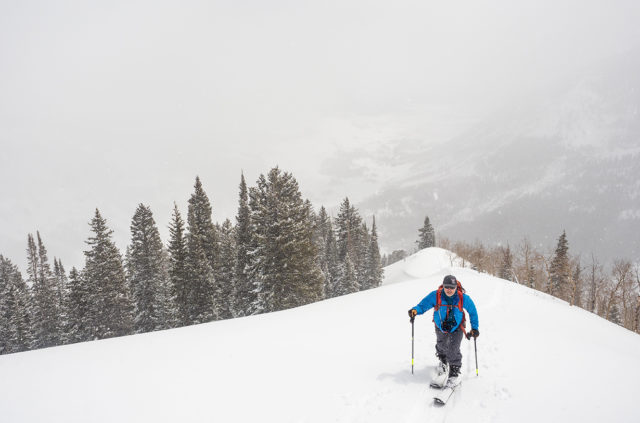
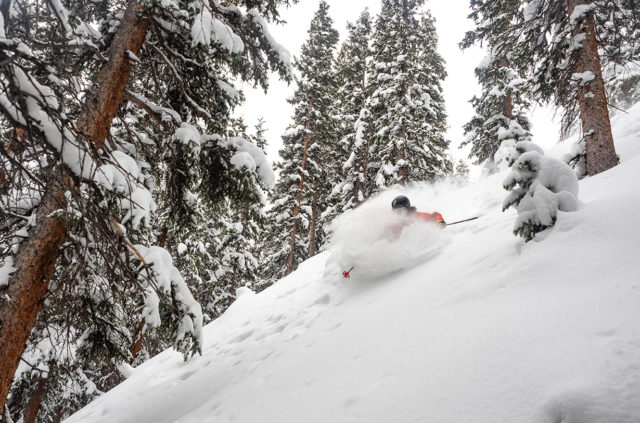
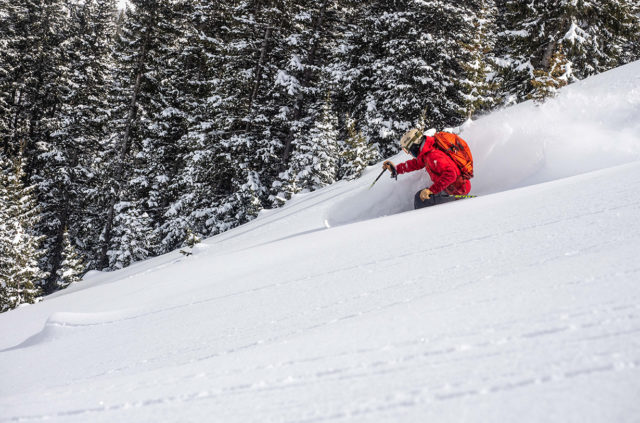
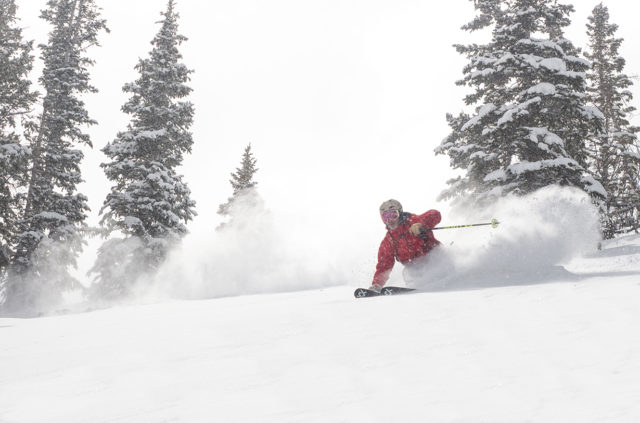
Not directly competing with Duke PT, but interesting in your deep dive context would be Kingpin M-Werks 12. Should be in the same weight category as Tecton, clearly lighter than the original Kingpin. Also as a combination of Kingpin-like heel and Alpinist toe, the construction is already proven. Do you have any plans reviewing that, or maybe you have already done so?
Unfortunately, we haven’t been able to try the M-Werks version, though we have been skiing some of the 20/21 regular Kingpins, which switched to the two-spring toe of the Alpinist and haven’t noticed any differences with that new toe. Everything about the M-Werks Kingpin makes me think it’d perform just like the regular Kingpin but lighter, with my main question being how durable that carbon material is. But we’re hoping to actually try that binding next season.
How do you feel about the 125mm brakes on a 110mm ski on groomers while laying out a wide high angle on edge?
We skied the Duke PT with the 125 mm brakes on the 106mm-wide Blaze 106 and I never noticed the brakes dragging while carving it, though I also don’t think I was carving quite as hard as I would on a perfect groomer. I did lay them over pretty hard though and never noticed an issue.
Hi as always a super helpful analysis for consumers – you are always my first point of reference. Any plans to include the ATK FR bindings in a free ride review?
We’ve used the ATK Raider 2.0 12 and the new R12, and can definitely add those to the comparison, though they feel like they’re in a bit of a different category than the other bindings we mentioned mostly due to weight.
There are actually three other systems that offer a pin/tech uphill and an alpine downhill solution. Don’t forget the BAM Pindung: http://bavarianalpinemanifest.com/
A little too heavy to be really interesting, I think, but it’s an option after all.
Ah, thanks for the reminder. I didn’t know that binding had made it to production yet. I’ll update that note.
Hey guys. Does the toe take a ski crampon?
Yes: https://www.marker.net/en-us/products/accessories/crampon-touring-acces/crampon-duke-pt-10409/
Does the Duke PT need a completely new mounting jig? Or is it used with either the jester jig or maybe the king pin??
Even though the Dynafit Beast is out of production, can you compare how it against the Beast (14 or 16) in regard to uphill / downhill performance?
What brake width do you think I’d need for my Lib Tech UFO 105’s? Feels excessive to go with a 125mm brake for that ski, no? Doesn’t look like the brakes retract inward at all when in downhill mode based on your photos.
Curious what size you decided to go with? Looking at the same set up now. Mixed feedback out there on whether the 100 will fit.
Whats the biggest difference between the 16 and the 12?
The DIN. 16 vs 12
Different heel. Jester v squire
Anyone know how the hole pattern if one want to remount a ski (ie a V-werks Katana) from a Marker Baron or Duke EPF to this new Duke PT?
google “marker binding paper template” and you can find many marker bindings. Binding Freedom [way better than quiver killer IMO] has many. I’ve found them in other spots too. Just make sure have your printer set to correct 100% and double check hard copy with a ruler
Just mounted these on my Bent Chetler 100s yesterday. It has a unique mounting pattern, so requires its own jig.
The brake is pretty generous, I would bet you could easily go with this 100 brake on a 105, you might need to bend it just a little.
The difference between the 16 and the 12 is just the DIN value. The heel piece is bigger and heavier on the 16 DIN. It is essentially the Jester heel piece, so if you look at the heelpice of the 12 vs 16 Jester, you will see what the difference is in the Duke PT.
Great analysis. This binding is certainly not cheap and having this background before buying is super helpful.
Hey guys, could I go for a downhill only with tech toe? Just thinking if I know I go only for a quick hike and easy downhill, maybe I could leave the alpine toe at home. What do you think?
From my understanding they are not designed to be skied in without the toe piece.
Tyler is correct — the tech toe piece is positioned in a way that would put the heel of your boot too far forward in front of the heel piece to ski down with your boots attached to the tech toe. And FWIW, Marker also says they did not design the tech toe with downhill skiing in mind.
Thank you very much for your answers
I am a huge Marker fan, but don’t get the weight savings “logic” of this new binding. It’s not *that much* lighter than their frame binding.
I have an older pair of tour f-12 “frame” bindings. They have two riser heights. They weigh 1117 g each [*including* the 9 “binding freedom” screws]. This new binding in uphill mode [at 1074g per] saves a grand total of 43g – less than 2 ounces. And you need to carry the [roughly] 300g toe piece up hill – granted not on your feet but still.
I guess it makes sense if you need a binding with a DIN higher than 12 and this binding provides a burlier ski/binding interface than their frame binding. I seem to recall athletes doing some heavy stuff on frame bindings in movies, but I would not know the requirements of big air in big terrain.
The shift is ~188g lighter [almost 6.7 ounces] on the uphill and does not require removing the toe piece so it’s much lighter on the downhill as well [in case that matters to you]. IMO this must have been a marketing “requirement” as Marker felt they had to issue their version, but they “failed” compared to the Shift. And this from a life-long Marker user.
At least for me, the Duke PT’s weight vs. frame bindings is much less important than the fact that the Duke PT lets me skin up with pins, since I never loved the pivot point of frame bindings and the fact that you have the weight of the frame / heel piece attached to your feet when striding. There’s no denying that the Duke PT is a heavy binding overall, but I definitely prefer skinning with it vs. any frame binding.
Agreed.
The Shift is a 13, the Marker is a 16. Not comparable in term of weight. Use the Duke 12 to compare…
Following up on the above question regarding this Duke PT vs. the traditional Duke frame binding. I have a separate touring set up with dynafit bindings and lighter touring boots for true touring days. The set up I am contemplating will be for resort skiing and short side country tours out of the resort.
The benefits I see in this binding over a frame Duke is that it would be lighter, nice touring with pins, and my boot will be closer to the ski without the frame acting as a riser.
The downside is that I love skiing true downhill boots for resort skiing rather than AT boots, which is something I can do with the frame Duke.
What do you reckon?
Hmm, if the skinning / touring on that setup will indeed be pretty limited / short, I’d lean toward a frame binding, especially if your touring boots are notably softer / lighter than your alpine boots. If you have pretty burly touring boots, then I’d lean Duke PT.
The review says the AFD will work with alpine toes, so you’re good there, just have to adjust back and forth.
Curious – did you use the old Hawx Ultra XTD or the new version with GW soles? Just thinking about as compatibility as the old Hawx Ultra XTD and Marker’s SoleID reportedly not compatible.
We were using the 20/21 Hawx Ultra XTD 130 & 20/21 Hawx Prime XTD 130, both of which feature GripWalk soles.
Just got these bindings, stoked how they feel. Sure they might be heavier but after a few sketchy pre releases on shifts last year in high speed alpine ski lines with snow quality varying due to slight variation of aspect (boot deep light snow to wind scoured) I am exciting for a solid binding that will not compromise the down. Comparing these to a frame binding seems silly; pin capabilities for uphill touring and ability to flex through the entire ski (unlike frame bindings) are amazing features that will be hugely beneficial to myself and others.
What do you mean by ‘practicing my 3s’?
That’s short for “practicing 360’s” — i.e., practicing spinning off jumps.
After using the PT for a few days now I can say that for the most part I am really happy. As a 220 lb skier who has always been frustrated with companies prioritizing weight savings over durability I am was interested when I heard of this new “super heavy” binding from Marker. It performed impressively well in almost all categories. The toe mechanism seems super solid both attached and detached and I don’t have much in the way of slop development concerns.
I do feel however that the brake/riser combination functions so poorly that I am at a loss for how it made it through R&D.
1: The flick lock mechanism that holds the break out of the way for skinning became engaged while I was skiing four times in two days. I stepped out and the brakes did not pop down when I stepped out. Main issue: skis sliding off after a fall or on transition if not noticed.
2: The 10 deg riser does not stay up. The flick lock mechanism that holds the heel pad down/brakes up has a fair bit of its on play out of the box to begin with. This sloppy foundation combined with the riser’s plastic to plastic interface which also has slop itself left me with heel risers that popped back down while skinning 20 plus times over the first two days. I got to the point where I had to pretend I was slab climbing and not load the heel risers abruptly or torque my foot in a switchback whatsoever to keep them in the right position. By the end of the second day, the plastic to plastic interface already was noticeably looser than when I had started.
It really boggles my mind as to how the final design was approved, especially when there are so many other heel riser mechanisms Marker has used in the past which have never been an issue. Unfortunately it’s not really something I can ignore unless I just want to tour flat all the time so before I get day three on my sturdy steeds I need to do some sort of troubleshooting.
So as to not just have complained and bounced, I would like to throw out a few ideas that could be passed along to the Marker elites:
-Don’t use plastic to plastic interfacing for anything that is small, subject to torques and the standard means of interaction is one where a boot is trying to push it back down. You’ve gone basically full metal on the whole binding, skimping for plastic here to save X grams seems silly.
-Use tempered metal to create a dynamic compression effect as the riser enters its up position so there is elastic absorption (like toe pieces) when these torques occur
-Take advantage of magnets if you don’t like the previous suggestion to draw the thing back into place
-Reverse the kingpin mechanism with a centre lever to actually get some solid enagement, not the flick lock that flips up while skiing.
-adopt an approach used on split boards and have a separately mounted riser that leaves only one pivot point for slop
-use the riser style of the kingpin….. it has to go the opposite way of where the boot is forcing it with each step to end up disengaged.
Overall it still doesn’t make me want to not use these as I really believe they are what I have been holding my breath for so I’d say 4/5
I have had issues with pin bindings opening up by accidentally bumping the release mechanism at the front while descending. Considering that the front release is external, unlike with the shifting binding while in descent mode, is there a change to trigger an unexpected release of the toe cap while in alpine ski mode?
One of the connection points between the alpine and tech toes on the Duke PT is automatically connected via the pressure of the boot when it’s in the binding in alpine mode, so theoretically, even if you managed to impact the toe lever, that connection point should still prevent the alpine toe from releasing.
Is there any updates on this binding for 21/22? For example the tech-toe lever that brakes easily
As far as we’ve been told by Marker, the binding has not been changed for 21/22. We have not had any durability issues with our pair, but have seen a few reports online from folks who have. I’ll see if I can get a more detailed response regarding the toe lever.
Thanks!
Duke PT 12 vs 16
I’m 165lbs, 5’7”, semi-aggressive skier looking for bindings for a 50/50 one ski quiver setup on Sick Day 104’s. On a budget. Someday I will get a real quiver but for now I need one binding to get me around.
With a DIN of 8, my initial thinking was the Duke PT 12 is only ~75g more than a Kingpin and I can have safer resort experience. But then I dug into what the difference b/w a Duke Pt 12 and 16 consisted of and the difference seems extreme.
Side-note, I had a pair of Shifts that frequently pre-released. I had them professionally serviced to no avail.
Duke Pt 12: I understand this is a Marker Squire heel. This seems like an inappropriate heel for an average sized, advanced male skier based on what I’m reading out there. E.g.
Jeff from Ski Essentials talking about the Marker Squire binding…This a binding that’s one of “the easiest to outgrow. I see a lot of kids I coach use and then a lot of light women use. When you get up to the 140/150lb range, even if you’re not super-aggressive, it might make sense to bump up to a griffon.”
Evo describes the Squire as “The best selling womens’ and “tweens” binding at Evo year after year.”
After listening to the Ep. 166 of the Gear 30 podcast with McKenna Peterson, I realize the whole conversation of gender specific equipment needs work. However, it feels reasonable to say this Squire binding is maybe not suited for more aggressive skiers who aren’t very light.
But then the Duke PT 16/Jester heel is explained as this wayyyyy different thing.
Jeff from Ski Essentials (and most blogs I read) talking about the Duke PT 16…
“If you’re THE most aggressive skier in the world…if you’re hitting 100’ jumps and dropping 50’ cliffs in the backcountry, this is the binding for it.”
That Duke PT 16 skier profile is on the opposite end of the spectrum relative to a light “tween.” What about the massive amount of skiers in between those extremes?
Do you think the the Duke PT 12 is gonna ski significantly different than the 16 for an average advanced skier around ~175lbs??
This is exactly where I’m at. My din is 9. I’m 5’10 and 175lbs. I ski warden 11 without issues. I’d like to save a few hundred grams for the pt12 and I can get a good deal on them.
Mostly use them for pow and soft snow skiing
Hi there
Thanks a lot for your great reviews. At the moment I’m really struggling with the decision between Salomon Shift and Marker Duke PT.
The weight isn’t too important for me because for longer touring I already have a real touring set-up with a Fritschi binding.
The new set-up I’m thinking about is with a Fischer Ranger 102 FR ski. Ski and binding will only be used for short uphills. The downhill performance is in this set-up the most important thing for me. What binding delivers more alpine binding feeling? Salomon Shift oder Marker Duke PT?
Thanks a lot for your answer.
marker duke pt is a better downhill performer.
will these bindings be compatible with the K2 mind bender 130 touring boots?
Wanted to pop into the conversation & say I’ve had issues with the toe lever breaking. Today when skinning, my boot came out of the toe & the lever was broken when I picked it up. The fall was a little more violent than usual- kick turn collapsed and I suddenly fell forward pretty hard- but not unreasonable for an uphill fall and definitely not something that should’ve broken the binding. I’m not sure why Marker went with plastic on the toe lever, but I was concerned about durability there from the moment I bought the bindings & that was validated today. It does not seem that the current Duke PTs are good for anyone looking for a durable binding.